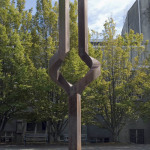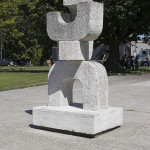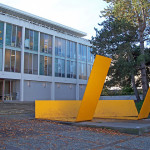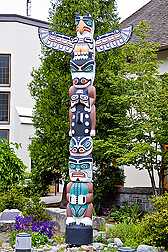The UBC Vancouver campus is full of a brilliant range of public art pieces that have been generously donated by alumni and community members. According to the Morris and Helen Belkin Gallery Outdoor Tour, the purpose of these art pieces is to “enrich the campus environment”. Many of them are in the form of sculptures (such as Gerhard Class’s Untitled (Tuning Fork), Robert Clothier’s Three Forms and Robert Murray’s Cumbria) which enhance the campus experience by improving the usually dull, grey tones of university buildings. Often, large sculptures act as a visual metaphor of the area they are situated in. Tuning Fork, for example, is located by UBC’s music, theatre, film and architecture department buildings to cohesively bring together the Arts precinct.
Public art can serve to improve communities by providing an avenue for intellectual and artistic dialogue, freedom of community expression, and a way for people to feel better about themselves and the place they inhabit. Public art provides people with an invaluable sense of community spirit and pride that is not possible when art remains a hidden and exclusive luxury. Many students choose to attend UBC because of its notable beauty; UBC administration claims to build aesthetically pleasing structures like the Martha Piper Plaza to attract foreign students to our campus. Campus aesthetics are a huge factor in not only student’s choosing to attend UBC but their sense of school pride whilst here. But why don’t students get any say in what they see on their campus? Who decides what is beautiful and therefore worthy of display?
The term public art describes art that was previously hidden in exclusive galleries being brought outside for all to see and engage with. It is important, therefore, to evaluate the connotations of creating public art on a university campus. How do we perceive the word public? It is often associated with lower classes (public schools, public assistance, public defender), while private is more elitist inferring that the purpose of public art is to target the less privileged, reinstating the exclusive nature of art in general. Are students being fed a version of beauty that has been decided by the university? Is the art even for us, or merely to maintain UBC’s public image and branding?
A lot of the public art at UBC aims to educate the student body about the heritage and history of the territory we inhabit, but it does not provide the necessary tools with which to observe and analyse the artworks. For example, Ellen Neel’s Victory through Honour and Jack Harman’s Portrait Bust of Dr. Norman A. M. Mackenzie represent important pieces of the history and culture of our university and the land on which it is situated. However, given the arguably high levels of apathy among students, it seems unlikely that there is much interest in the historical and cultural meanings behind the public art on campus.
Some forms of public art, especially graffiti, are universally criticised. Not only is graffiti illegal in many cities and seen by most as a form of vandalism, famous street artists like Banksy have been accused of causing gentrification in deprived urban areas. Research also suggests that the prevalence of graffiti in certain areas acts as a catalyst for more vandalism and subsequently social decline. UBC, like most urban spaces, has a number of unconventional and unauthorised forms of public art. Washroom walls are decorated with bathroom-musings, billboard faces grow moustaches and posters blanket walls. Is a scrawl on a washroom wall the same as a bronze sculpture of a former UBC president or totem pole carved by a renowned Kwakwa̱ka̱’wakw artist? Possibly not in the elite world of art, but maybe to students who are using different forms of public art to own their campus. Perhaps UBC students are determining for themselves how they wish to decorate the place they live, work and study.
In a rogue, secretive fashion, people come out at night to decorate the Engineering Cairn to represent or advertise their own cause or initiative. This uncommissioned, community-led artwork goes unsolicited and the artists unpunished, meaning that this vandalism is accepted as a form of public art that both improves the community’s sense of pride and spirit and creates a downward spiral of continual destruction. A recent letter to The Ubyssey from the Engineering Cairn itself, emphasises the importance of this structure. It stresses that if we are going to come out in the dead of night to create inter-faculty competition, we must “do better”. Random scrawls reminiscent of bathroom graffiti is not good enough: the Engineering Cairn only accepts well-crafted and meaningful paintings upon its surface. Is this an internalised artistic elitism speaking? Have we become so spoilt with the world-class campus aesthetics that we are now policing the quality of midnight graffiti?
Digging deeper into this, we can even begin to question the impact of having one sole location where students are able to express their creative freedom. While alumni and community members can donate huge structures to be placed on campus with no student consultation, current UBC students have one, single place on campus where they can be artistic. Why are there no murals, open canvases or interactive art pieces like the Douglas Coupland installation at the Vancouver Art Gallery? With $5 million recently donated to UBC for the creation of the new Audain Art Centre, the large, centrally located Belkin Art Gallery and the AMS Art Gallery, we can assume there is no shortage of interest for visual arts at UBC, not to mention a thriving Art History, Visual Arts and Theory department.
UBC needs more art by and for students. UBC needs to allow students to make campus their own. UBC needs to provide us with art that creates necessary and engaging dialogue. Students have presented what they perceive as public art: interactive, changing, and community-led. This is a call to eradicate the omnipresent elitism of art that dictates what we can and cannot see, what we can and cannot touch. This is a call for students to come forth and define their own standards of beauty. This is a call to create space for expression, creative freedom and student art.








